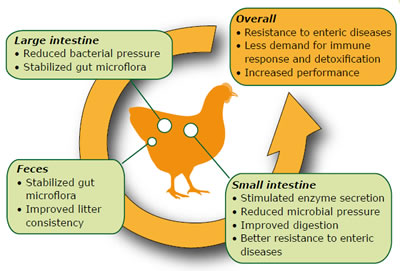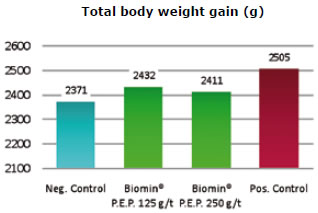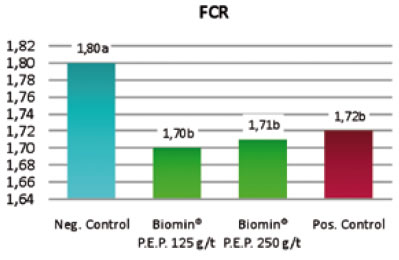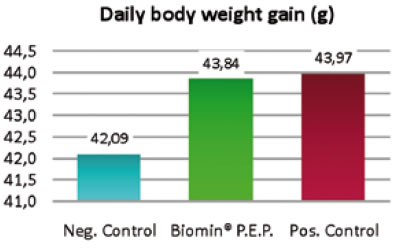New Concepts on the Horizon: Phytogenics in Poultry Production
Modern poultry and egg production is facing several challenges. Growing demand for poultry products and rising prices for raw materials require the implementation of optimal production conditions with the aim to secure high animal performance. Phytogenic feed additives have gained considerable attention in the feed industry and producers are increasingly incorporating them into feeding programs. Today, 61 (non-EU) or 70% (EU) of the companies are using phytogenic additives in broiler feeds (World Poultry, 2008). In comparison to Antibiotic Growth Promoters, phytogenics usually do not bear the risk of cross-resistances and residues in animal products. Improvements in feed conversion ratio (FCR) and body weight gain, as well as their benefits in helping to prevent intestinal diseases (such as Necrotic Enteritis) have been observed in recent trials with BIOMIN's phytogenic performance enhancer Biomin® P.E.P.
Information about the mode of action of commercially available phytogenic feed additives is rather scarce. It can be speculated that phytogenic feed additives vary greatly with regard to their in vivo effects in the animal. This variation is due to differences in the composition and biological activities of such feed additives. Assessment of biological effects is difficult if the composition of a test substance is unclear or variable. With Biomin® P.E.P. there is a defined phytogenic feed additive with standardized composition which is based on carefully selected raw materials.
What can we expect from a phytogenic feed additive?
Recent facts from studies with swine indicate that the mode of action of Biomin® P.E.P. is versatile and conclusive (Kroismayr, 2007). It was shown in this work that addition of Biomin® P.E.P. to basal diets resulted in a reduction of the total bacterial count in the intestine, increase of nutrient digestibility (Stony et al., 2006), decreased levels of microbial toxins in the gut and, therefore, a down-regulation of the immune system. Finally, this indicates that more energy and nutrients are available for accretion of body mass (energy and nutrient sparing). Furthermore, there is evidence that phytogenics stimulate digestive secretions such as saliva or endogenous digestive enzymes (Platel and Srinivasan, 1996).

Figure 1 Biomin® P.E.P.: How it works
In the meantime, additional studies are under way to further identify potential mechanisms associated with the incorporation of phytogenics in diets for different species.
Phytogenics in broiler production
Biomin® P.E.P. was tested in different dosages in a scientific trial at the Agricultural University of Athens, Greece. Dayold, male Cobb broiler chicks were assigned to different treatments, comprising 3 replications per treatment and 105 birds per treatment. The Negative Control (NC) contained no growth promoters, whereas the Positive Control (PC) contained Avilamycin. In further treatments, Biomin® P.E.P. 125 poultry was supplemented at 125 or 250 g/t, respectively. As shown in Figures 2 and 3, Biomin® P.E.P. increased body weight gain and significantly improved FCR. Differences between the dosages of Biomin® P.E.P. were minor, indicating that the regular inclusion level of 125 g/t was optimal under the experimental conditions herein.

Figure 2 Effect of phytogenics and an Antibiotic Growth Promoter on total body weight gain of broilers (Agricultural University of Athens, Greece)

Figure 3 Effect of phytogenics and an Antibiotic Growth Promoter on FCR of broilers (Agricultural University of Athens, Greece)
Similar positive results were obtained in a 45-day study conducted in Thailand. In this trial, the impact of Biomin® P.E.P. was investigated in one-day-old Ross broilers, which were assigned to 4 dietary treatments. The treatments were (1) Negative Control (NC), (2) Biomin® P.E.P., (3) Positive Control (PC) containing Flavomycin. Monensin was included in the starter and grower diets as anticoccidia agent. Compared to the NC, Biomin® P.E.P. increased daily weight gain by 4.2 % (Figure 4). FCR amounted to 1.77, 1.71 and 1.75 in the NC, Biomin® P.E.P. treatment and PC, respectively, (Figure 5) and mortality was 1.12, 0.36 and 0.59%, respectively, in these treatments.
The Productivity Index [PI = Livability (%) × Live weight (kg) / age (days) / FCR × 100] was 250, 255 and 235 in treatments 1, 2 and 3. Positive effects of phytogenics on broiler performance were also obtained by Cross et al. (2007) and Bölükba?i et al. (2006).

Figure 4 Effect of phytogenics and an Antibiotic Growth Promoter on average daily weight gain of broilers (Kasetsart University, Thailand)

Figure 5 Effect of phytogenics and an Antibiotic Growth Promoter on feed conversion ratio of broilers (Kasetsart University, Thailand)
Phytogenics in egg production
The effects on performance and economics of Biomin® P.E.P. were investigated in the early stages of the egg production cycle in the Bangkok Animal Research Center (BARC) (Nichol and Steiner, 2008). A 12-week trial was carried out with high-performing, female Lohmann Brown hens, using six replications with 16 birds per replication in a randomized complete block design and resulting in 96 hens per treatment. The age of the birds at the beginning and conclusion of the trial was 20 and 32 weeks, respectively. The birds were assigned to two dietary treatments: (1) Control (no additives), (2) Biomin® P.E.P. As shown in Table 1, hens fed phytogenics consumed less feed and had higher egg production as compared to the control birds. Total and average daily feed intake was lower by 1.8% when the control diet was supplemented with phytogenics.
Table 1 Effects of phytogenics on average performance parameters (week 20 to 31) of layers (BARC, Thailand)
| Control | + Phytogenics | Difference (%) | |
| Daily feed intake per hen (g) | 112 |
110 |
- 1.8 |
| Total feed intake per hen (kg) | 9.42 |
9.26 |
- 1.8 |
| Egg production (%) | 92.6 |
93.5 |
+ 1.0 |
| No. of eggs per hen | 77.8 |
78.6 |
+ 1.0 |
| FCR (kg feed/ kg eggs) | 2.069 |
2.034 |
- 1.7 |
Hens offered phytogenics produced more eggs and had a better feed conversion in comparison to birds in the control group. Additionally, supplementation of the diets with phytogenics improved egg shell parameters (Table 2), i.e. shell thickness (P<0.05) and albumen height. As indicated by a higher Haugh Unit rating (82 vs. 79), the internal egg quality was higher in hens fed phytogenics.
Table 2 Effects of phytogenics on egg traits in layers (BARC, Thailand)
| Control | Difference (%) | |
| Shell thickness (mm) | 0.416b | 0.478a |
| Albumen height (mm) | 6.57 | 7.09 |
| Haugh Units1 | 79 | 82 |
| a,b Means with different superscript letters differ significantly (P<0.05) | ||
| 1 Haugh Unit is a correlation between egg weight and albumen height. | ||
Based on actual local prices, Biomin® P.E.P. improved productivity, resulting in a 1.4% cost saving (47.09 vs. 47.74 USD per 1000 eggs).
Specific applications of phytogenics
As shown in the trial reports above, Biomin® P.E.P. works well as performance enhancer when it is included in the feed. Additionally, due to the effect of its active ingredients against several gram-positive and gram-negative bacteria, Biomin® P.E.P. represents a solution to prevent and overcome critical stages in the production cycle. Such stages include vaccination or a change of diets or feeding regimen, for example as the birds switch from starter to grower or from grower to finisher diets. Such changes disrupt the digestive process that can alter the balance of microorganisms in the gut. These disruptions invite pathogenic proliferation such as Salmonella, Clostridia, E. coli, and others. The use of Biomin® P.E.P. helps to prevent and overcome such challenges. In addition to the powdered formulations of Biomin® P.E.P. there is also the liquid formulation Biomin® P.E.P. sol, which is the ideal means for a short-term, high-dosage application to drinking water in these critical stages. Finally, recent work is in progress at the US Department of Agriculture (USDA) to identify the potential of phytogenics to reduce the clinical signs of Necrotic Enteritis (NE) in broilers. The first results are extremely promising, showing that Biomin® P.E.P. had a highly beneficial impact in alleviating NE symptoms in birds that had been challenged with Clostridium perfringens, which is the main causative agent of this damaging, costly disease (Mc Reynolds et al., 2008).
Conclusion
Phytogenics represent one of the most promising groups of performance-enhancing feed additives. It should be kept in mind that only a well-balanced and scientifically developed combination of active ingredients with defined properties can be expected to function synergistically in order to bring about the desired benefits for the producer. In this sense, Biomin® P.E.P. is the phytogenic solution of choice, combining a proven mode of action with consistent, positive effects on animal performance.
For more information please visit www.biomin.net













 BIOMIN Holding GmbH
BIOMIN Holding GmbH +43 2782 803 0
+43 2782 803 0






